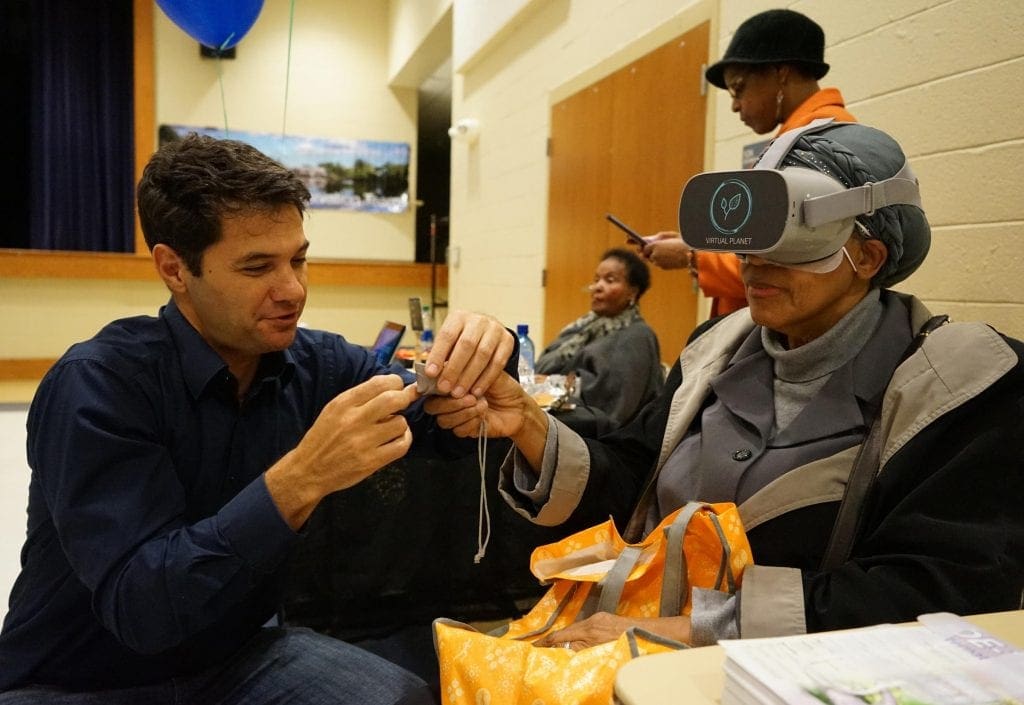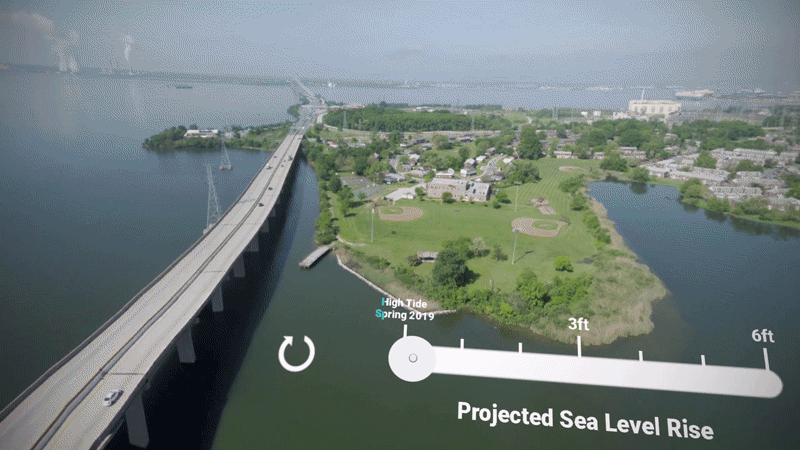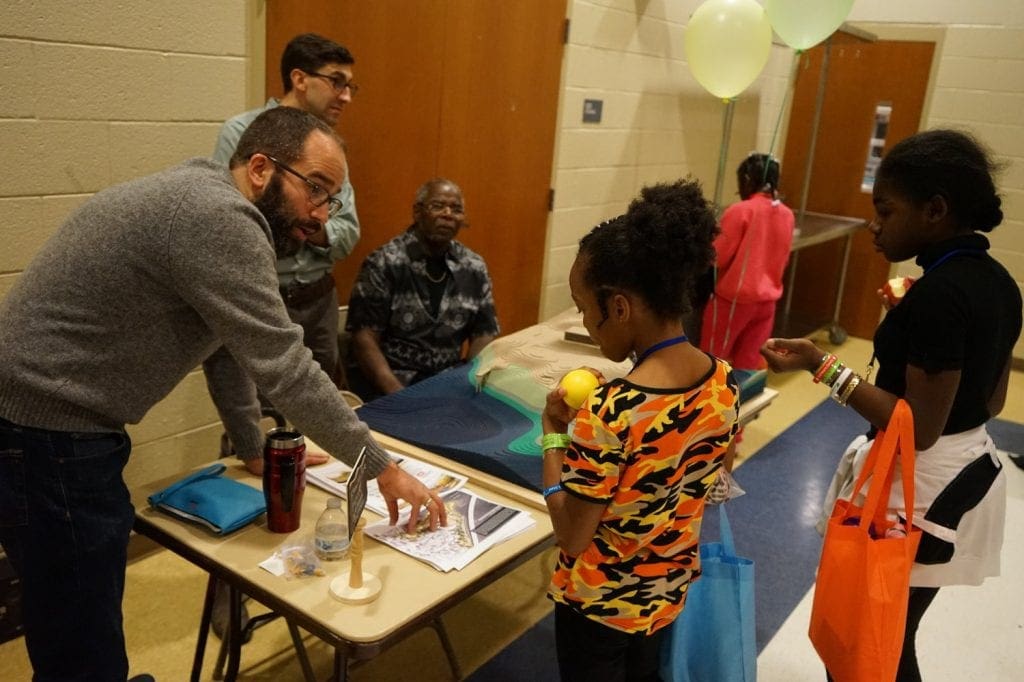
The reed-covered shorelines are first to go. Then, the baseball fields at Fleming Park. By the time seawater reaches the senior center, it has inundated streets, flooding more than a dozen multiunit brick homes that she can see.
Monroe moves her head up and down, side to side, taking in the sobering simulated view. This is what could happen to Turner Station, a historic African American community southeast of Baltimore, as sea levels rise.
“Everything’s underwater. The school is underwater. Our house is underwater,” Monroe says. A frown forms below the bulky gray virtual reality headset covering her eyes. “Is the water really supposed to get that high?”
Climate change presents many challenges to coastal communities and to those trying to prepare for its impacts, but one of the most basic is also one of the most vexing: How do you show people — and convince them — of a possible future?
It’s one thing to hear or read that sea levels could rise as high as 7 feet in Maryland by the end of the century under worst-case scenarios, but it’s another “to imagine what that will look like in your own backyard,” says Jackie Specht, the coastal science program manager for The Nature Conservancy’s Maryland/DC Chapter.
“And if it’s hard to imagine, it’s hard to face and prioritize, especially when there are so many tangible issues that [people are] facing in the day-to-day.”
Communicating the realness and immediacy of the climate threat is hugely important to climate researchers and those aiming to mitigate its causes. But it’s also paramount to communities faced with coming changes that are already unavoidable.
Climate resiliency projects need public support and input.
That’s why Monroe and other residents at this recent community meeting are being directed to sit in metal chairs, put on virtual reality headsets and watch their homes flood.
Turner Station is trying to prepare.
“Slogging through water”
Flooding is nothing new to Turner Station.
The community sits on a little peninsula that juts south into the Patapsco River and the greater Baltimore Harbor. To the west are the tall cranes of the Port of Baltimore. To the east, across a wide creek, is Sparrows Point, the former site of a massive steel company and industrial complex that, for decades, employed most of the community’s residents.
Larry Bannerman, a lifelong resident and a board member for Turner Station Conservation Teams, says that water has always run south down the peninsula in big rain events, flooding parts of town and the low-lying, waterfront baseball fields at Fleming Park.
But not like it does now.
“I don’t ever remember running in the outfield and slogging through water,” Bannerman says, walking alongside one of the baseball fields in a pair of rubber boots. Now, he says, it has become so common that the fields hardly see any use.
The county has built outfalls, structures where water can drain into the harbor, along the end of the peninsula and at Fleming Park. “But you probably couldn’t see them right now because they’re underwater,” he says. “They’re not supposed to be.”
Planning for the future
Sea level rise often gets talked about as a far-off event, but Maryland and much of the East Coast are already feeling the effects. Coastal erosion is accelerating. Wetlands are deteriorating. High-tide flooding occurs with greater frequency.
A 2018 report by the University of Maryland Center for Environmental Science says, “The level of Chesapeake Bay water with respect to the land is now rising about three times as fast as it was during Colonial times, threatening more densely built communities and infrastructure that developed over the interim.”
The threat isn’t lost on Turner Station, which has partnered with the Port of Baltimore, a few nonprofits and a local landscape architecture firm to create a project that would reshape Fleming Park and mitigate the risk of future floods.
The project calls for taking dredged sediment from Baltimore Harbor and Chesapeake Bay and using it to beef up the local shoreline and give it a more resilient edge. The design would help offset erosion and provide added defense against storm surge.
But some in the community worry about the use of dredge material at a public park, given the industrial pollution that has historically occurred in the area. It’s a worry that Bannerman and other project leaders say is unfounded; any material that would be used would first be tested for contamination.
“We need the whole community on board with this,” says Gloria Nelson, president of Turner Station Conservation Teams. “Rather than [an] agency coming to us and telling us: ‘This is what we’re going to do in your community.’ ”
To get that buy-in — and to make their case to potential funders — the project’s organizers are going to incredible lengths to communicate their plans and the risks of inaction.
Mahan Rykiel, the local landscape architectural firm that created the conceptual designs for the project, has created three-dimensional topographic maps of the area and two-dimensional illustrations to bring to community meetings.
Project organizers have given tours at the park, talking through the planned changes.
“You need a range of tools and a range of ways to communicate [climate change] to the public, because every person is different and every place is different,” says Isaac Hametz, the firm’s research director.
The virtual reality program is only the most recent — and, perhaps the most effective, step.
Starting a conversation
Virtual reality is an immersive experience that can trick the human brain into thinking it’s real. But tricking people is not the goal of the sea level rise simulation being used at Turner Station, says Juliano Calil, one of the program’s developers.
The goal, he says, “is to start a conversation and help folks visualize the impacts [of climate change] and the solutions, and also discuss the trade-offs between them.”
Calil is an adjunct professor at the Middlebury Institute of International Studies at Monterey in California and a research fellow focused on coastal adaptation. He’s also a licensed drone operator and an early adopter of virtual reality.
A couple of years ago, he had the idea of pairing those skills with his climate work and set out to make a sea level rise simulation for his current hometown, Santa Cruz, Calif.
He recruited a video game designer to create the models, using elevation maps, aerial footage he recorded with his drone and the most recent sea level rise projections.
“We spent a week in my living room and did a prototype in VR and it worked,” Calil says. “And I think that’s indicative of what we need to address climate change: No matter what skill you have, there is a way that you can apply that to help solve the problems.”
The Santa Cruz program is housed in a local library for residents to use, and Calil has started work on another simulation for Long Beach, Calif. There, instead of a lower-income neighborhood like Turner Station, the area at risk is a narrow strip of expensive beach homes.
Each project shows the communities and shoreline as they look today from a bird’s-eye view. A slider at the bottom lets the user bring sea levels up as narration explains what the viewer is seeing.
Future versions, Calil says, will also integrate proposed solutions. If a community is considering building a sea wall, for example, “we can show the sea wall and look at the impacts to the beach,” he says. “You have a sea wall, but over time, you may lose the beach.”
Giving people a clear sense of those trade-offs, he says, should make for a better-informed discussion around climate resiliency projects, and showing people the risks should spur interest and participation.
At Turner Station’s community meeting in southeast Baltimore County, Eric Johnson, pastor of the Union Baptist Church, removes one of the virtual reality headsets and blinks as his eyes adjust to the auditorium’s bright lights.
Asked about his experience, he pauses.
“You hear about global warming and the effects of it, but to really be able to see it in real time is an eye-opener,” he says. “It shows you this is something we needed to work on, like, yesterday.”
Source: Environment : NPR










